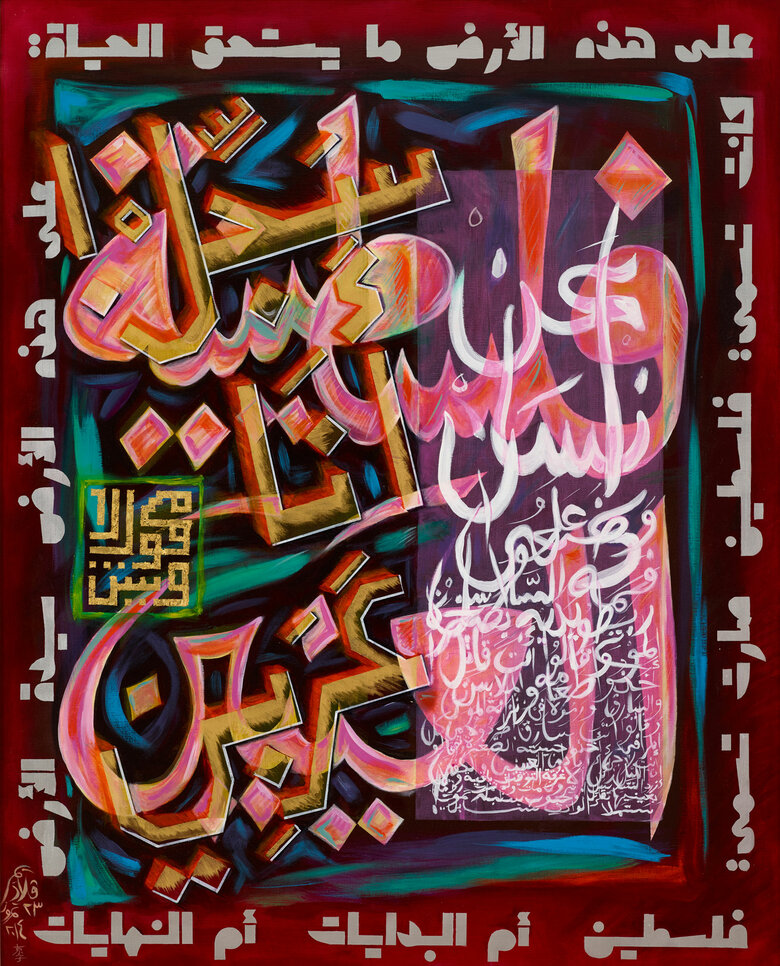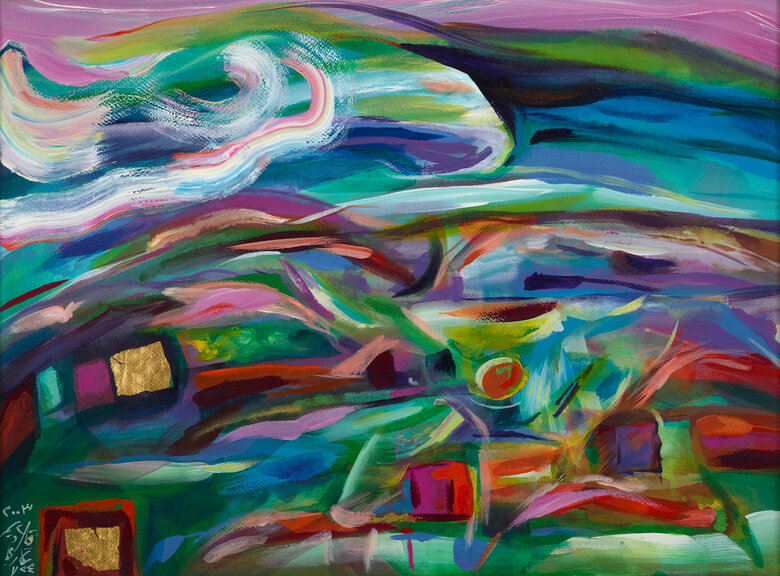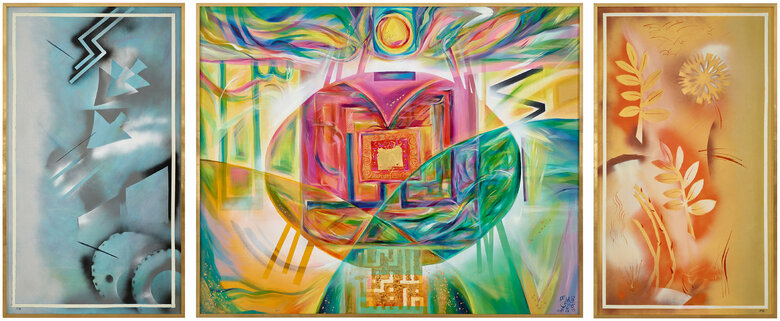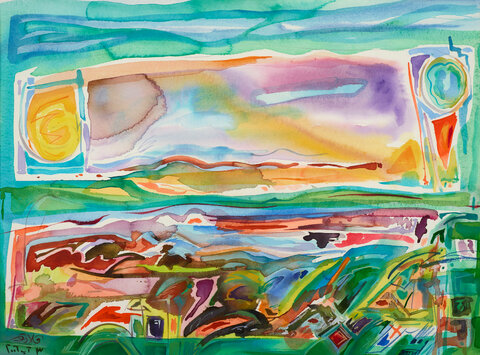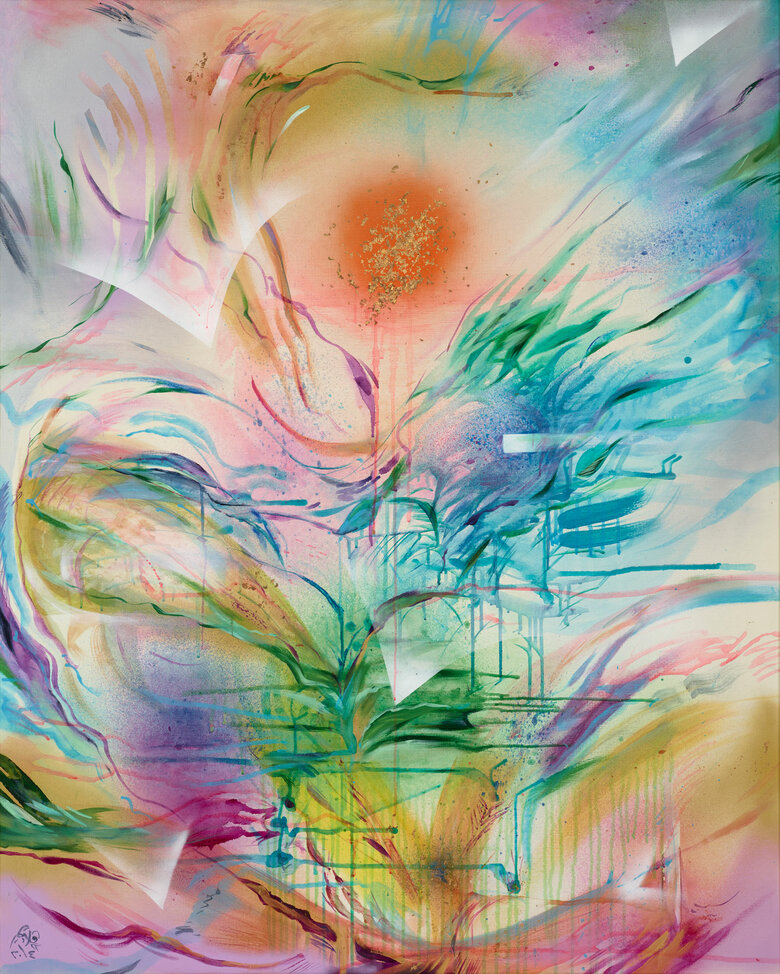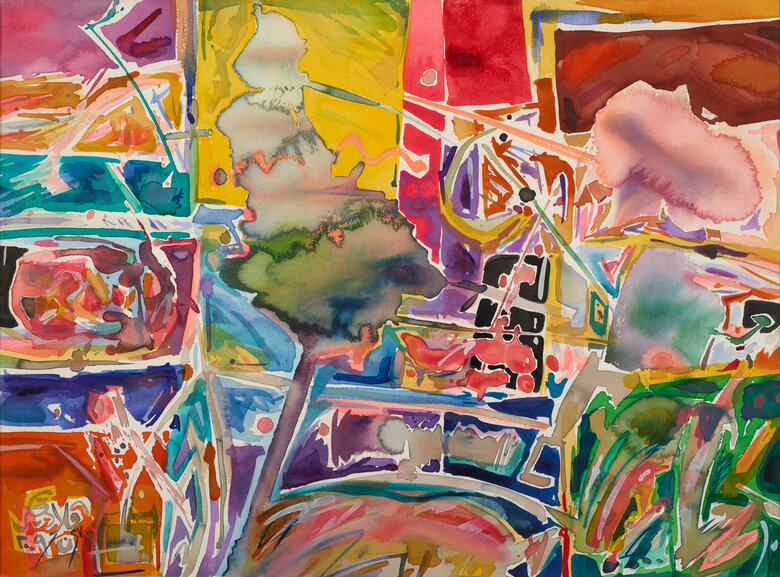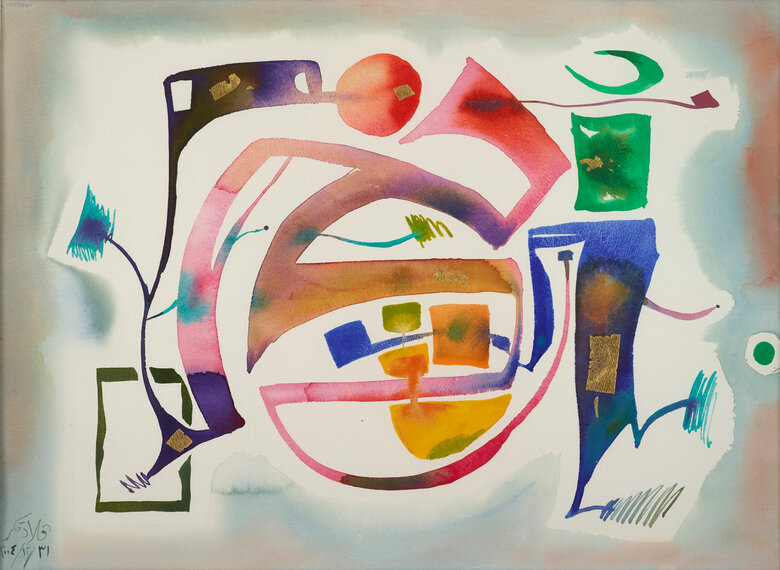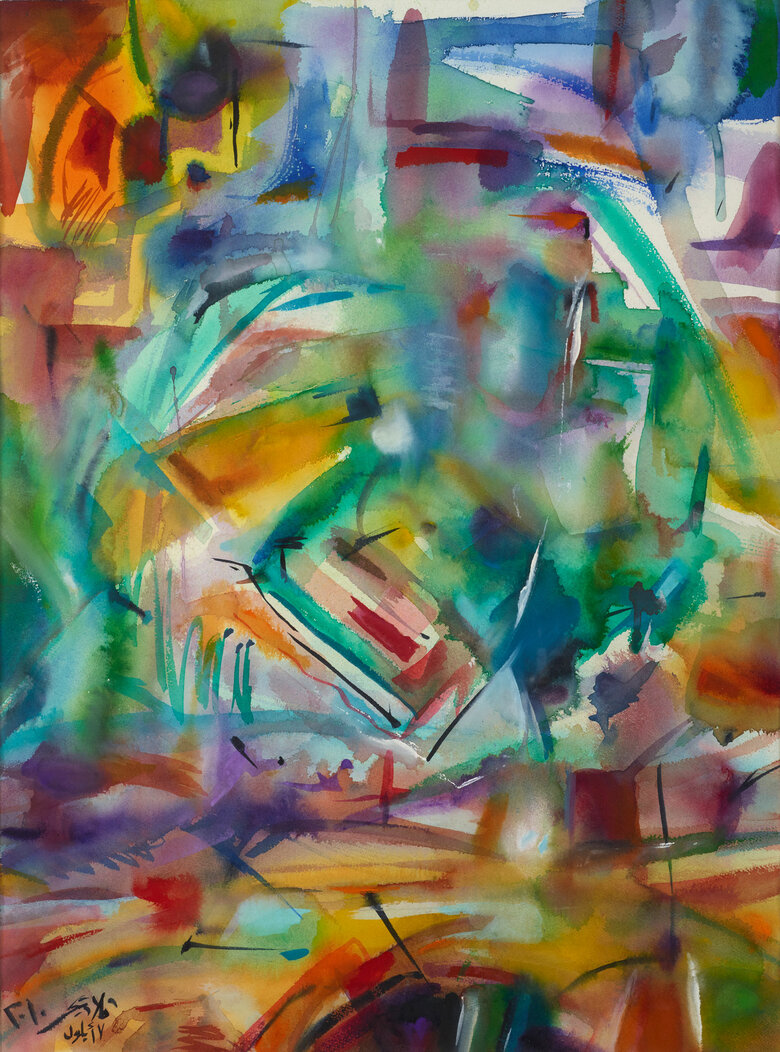Vladimir Tamari was born in Jerusalem in 1942. After completing his primary and secondary educations at a Quaker school in Ramallah, he went on to study physics and art at the American University...
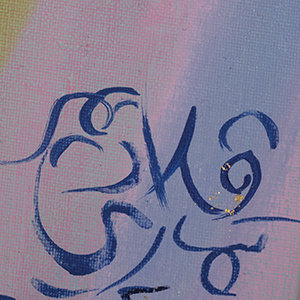

VLADIMIR TAMARI, Palestine (1942 - 2017)
Bio
Written by Alessandra Amin
Vladimir Tamari was born in Jerusalem in 1942. After completing his primary and secondary educations at a Quaker school in Ramallah, he went on to study physics and art at the American University of Beirut. In 1963, Tamari spent a year at Saint Martin’s School of Art in London, after which he spent another year at Pendle Hill School Quaker Center of Study and Contemplation in Philadelphia, Pennsylvania. Between 1966 and 1970, Tamari was based primarily in Beirut, where he worked with UNRWA to document the plight of Palestinian refugees on film. During this time, he also worked with Jordanian artist Mona Saudi on a book of drawings and interviews with Palestinian refugee children and produced cartoons and graphic design in support of the growing Palestinian liberation movement. The artist then relocated permanently to Japan, where he and his wife Kyoko raised two daughters. He spent the rest of his life in Kyoto and Tokyo as a modern-day “Renaissance man,” exploring his interests in fine arts, graphic design, physics, and industrial design.
Reflecting on his childhood in 1991, Tamari claimed that four significant influences shaped his formative years: church life, the surrounding culture of Islam, Palestinian and Arab nationalism, and “a veneer of European ‘modern’ culture and values” adopted by upper-class, educated Arabs. Tamari’s family belonged to the Eastern Orthodox Church, and their religious traditions brought him into contact with other cultures at a young age. His maternal grandmother facilitated visits to the Holy Land for Orthodox pilgrims from Russia, which is how the artist claimed to have come by his Russian, first name. From his youth, Tamari showed unusual curiosity about the world around him, and his parents encouraged his creative endeavors rather than attempting to force the boy into pursuing something more “practical.” His sister, Vera, also benefitted from this environment, becoming a successful artist, potter, curator, and historian of Islamic art.
Throughout his career as an artist, Vladimir Tamari has worked primarily in watercolor and acrylic paint, approaching both with a unique sensitivity to light and color. “As a young child,” the artist recalled, “I was fascinated with the rays of sunlight entering the gloomy attic of my home through a cracked roof tile and watched with fascination the particles of dust dancing in the light.” This interest in sunlight found its way into Tamari’s paintings, which often feature bright rays of color or areas that seem to glow with a hazy, ethereal warmth. His abstract compositions are done in a style all his own, their animated shapes and vivid colors simultaneously evoking the work of artists as diverse as Keith Haring, Georgia O’Keeffe, Mona Saudi, Etel Adnan, and Gino Severini without ever truly mirroring them. The balance of hyper-saturated pigments and gentle pastel washes that define his watercolors is almost hypnotic. Yet, the artist insisted upon their spontaneity; per his description, he did not study or “think” about color in a logical way but approached it as a primitive and instinctive mode of expression, rooted in the bright hues and clear light of his Palestinian childhood. The play of solidity and transparency that distinguishes much of his oeuvre is also related to the social climate in which he came of age. Watching Palestine scramble to adjust and react to the new Israeli regime, Tamari was inspired by the clash between his “ancient culture” and “the need for swift adjustments to absorb the shock of new values and realities.” His paintings were thus “influenced by the solidity of rocks and stones, yet tempered by a knowledge that even rocks and stones are affected by the flow of light or water.” This sensibility in his work combines “immovable solidity and ethereal transparency, a love for the tangible and the traditional combined with an irrepressible imagination and need for change.”
In addition to visual art, Tamari was an avid inventor and spent much of his time immersed in the study of physics. Of the many optical and technical devices he designed, the three-dimensional drawing instrument stands out as a testimony to the artist’s interest in bending the rules of the physical world. The “3DD,” as he called it, is a device that allows the artist to “draw in space” by moving a handle that creates two simultaneous stereoscopic views. When observed through a double-lens stereoscope, the resultant image appears “three-dimensional” to the human eye. Tamari created the first prototype of the 3DD in Jerusalem in 1964, but it was lost when his home was hit by a rocket in the 1967 war. He subsequently spent 15 years building and perfecting hundreds of models of the instrument.
Vladimir Tamari passed away in Tokyo in August 2017. Only hours earlier, he had finished his final painting, which depicted a blossoming cherry tree in a park near his home.
Sources
Kamal Boullata, Palestinian Art from 1850 to the Present, London: Saqi, 2009
Vladimir Tamari, “Influences and Motivations in the Work of a Palestinian Artist/Inventor,” Leonardo v. 24 n. 1, February 1991
Anne Mullin Burnham, “Three From Jerusalem,” Aramco World, July-August 1990
Artist’s personal website, www.vladimirtamari.com
Tania Tamari Nasir, “Vladimir Tamari,” This Week in Palestine http://thisweekinpalestine.com/vladimir-tamari/
“Artist profile: Vladimir Tamari,” Birzeit University Museum website, http://museum.birzeit.edu/artists/vladimir-tamari
CV
Selected Group exhibitions
2023
The Little Prince of Gaza, Dalloul Art Foundation, Beirut, Lebanon
2021
Postcolonial Ecologies, Darat al Funun, Amman, Jordan
2019
Intimate Terrains: Representations of a Disappearing Landscape, ThePalestinian Museum, Birzeit, occupied Palestine
À la plume, au pinceau, au crayon:dessins du monde arabe, Institut du Monde Arabe, Paris, France
2018
Subcontracted Nations, AM Qattan Foundation, Ramallah, Occupied Palestine
Keyword – Palestine,Dar El Nimer, Beirut, Lebanon
2017
Jerusalem Lives (Tahya Al Quds), The Palestinian Museum, Birzeit, Occupied Palestine
Imago Mundi: Mediterranean Routes, ZAC – Zisa Zona Arti Contemporanee, Palermo, Italy
2016
Unlike Other Springs, Birzeit University Museum, Birzeit, Occupied Palestine
2015
SELF: Portraits of Artists in Their Absence, National Academy Museum, New York City, USA
2012
The Power of Words, Darat al Funun, Amman, Jordan
2009
Lexicon of Colors, al-Hoash Art Court, Jerusalem, Occupied Palestine
1978
International Exhibition for Palestine, PLO Plastic Arts Division, Beirut, Lebanon
Collections
Institut du Monde Arabe, Paris
British Museum, London, UK, France
Bryn Mawr College, Pennsylvania, USA
Royal Collection, Amman, Jordan
Jordan National Gallery of Fine Arts, Amman, Jordan
The Birzeit University collection, Ramallah, Occupied Palestine
The Khaled Shoman Foundation: Darat Al Funun, Amman, Jordan
Ramzi and Saeda Dalloul Art Foundation, Beirut, Lebanon
Private collections in Japan, Palestine, Lebanon, Jordan, Greece, Switzerland, Germany, France, USA, Dubai, Australia, Syria, Sweden, and the UK.
Documents
Bus 18 Then: A Portrait of “Eluds” by A Young Artist Now Grown Old
Vladimir Tamari
Jerusalem Quarterly, English, 2009
A Visual Aid for Artists with Retinitis Pigmentosa ('Tunnel Vision')
Vladimir Tamari
The MIT Press, English, 1985
Anamorphosis and the Eccentric Observer: Inverted Perspective and theConstruction of the Gaze
Vladimir Tamari
The MIT Press, English, 1993
The Micro Structure of the Universe Explains How it Works, How We Think, Our Physics, & the Tricky Effectiveness of Mathematics in That Physics.
Vladimir Tamari
fqxi.org, English, 2015
BEAUTIFUL UNIVERSE SIMULATION Part 1: proof of concept of energy transport in a simple 2-D array of nodes
Vladimir Tamari
Research Gate, English, 2016
HOW MY 1983 IDEA FOR A SUPER-RESOLVING SINGLE-MOLECULE FLUORESCENCE MICROSCOPE INDEPENDENTLY WON THE 2014 NOBEL PRIZE IN CHEMISTRY
Vladimir Tamari
Research Gate, English, 2016
Painting The Music Part 1.pdf
Is reality digital or Analogue Vladimir Tamari.pdf
Influences and Motivations in the Work of a Palestinian Artist/Inventor
Leonardo 24 No.1, English, 1991
فلاديمير تماري يتذكر صديقه هاني جوهرية
Vladimir Tamari
Arabic, 2016
THREE MAGNETIC DIPOLES PROVIDE A PHYSICALLY REALISTIC SIMULATION OF THE REPULSIVE-ATTRACTIVE NATURE OF THE STRONG FORCE AND OF THE CABIBBO ANGLE
Vladimir Tamari
English, 2016
EINSTEIN THEORIZED, BUT THE UNIVERSE, LIKE OLD MAN RIVER, JUST KEEPS ROLLING ALONG
Vladimir Tamari
English, 2017
Beautiful Universe: Towards Reconstructing Physics From New First Principles
Vladimir Tamari, English, 2005
How should humanity steer the future? An interview with Einstein in Heaven
Academia, English, 2014
The_Genius_of_Arab_Civilization.pdf
Fix Physics! – Reverse Engineer Relativity, Quantum Mechanics and the Standard Model, Get Rid of Outdated Assumptions, Consolidate, and Reconstruct On New First Principles
Academia, English
The Cloud of Unknowing & the Itsy Qubitsy Universe
Academia, English, 2013
Press
فلاديمير تماري.. صاحب "حرف القدس" يرحل في طوكيو
العربي الجديد, Arabic, 2017
رحيل الفنان الفلسطيني فلاديمير تماري
ضفة ثالثة, Arabic, 2017
رحيل الفنان الفلسطيني فلاديمير تماري أحد رواد الفن التشكيلي الفلسطيني
عبد ا لله أبو راشد
Tanwer.org, Arabic, 2017
Why you should care Because every cause needs a strong identity
Tafline Laylin
OZY, English, 2017
إعلان الفائزين بجائزة القدس للثقافة والإبداع
Al Jazeera, Arabic, 2018
Past Disquiet: Artists, International Solidarity and Museums-in-Exile Book Launch and Presentation
Sursock Museum, English, 2018
The Arab Spring and its impact on Art Today's Arab art
Mori Art Museum, English, 2013
فلاديمير تماري يغادر ووراءه خطوط ثلاثية الأبعاد
ميموزا العراوي
صحيفة العرب, Arabic, 2017
THE WAR ON GAZA: In the Company of Stories and Images
Tania Tamari Nasir
Vladimir Tamari, English, 2009
Vladimir Tamari talks about Edward Said and their meeting in Tokyo. An interview with Yuzo Itagaki
Vladimir Tamari, English, 2003
معرض في القدس يعيد التذكير برواد الفن التشكيلي الفلسطيني
Reuters, Arabic, 2009
The Jerusalem of Palestinian Artists
Mari Mmina
BAB, English, 2009
VLADIMIR TAMARI Artwork
Become a Member
Join us in our endless discovery of modern and contemporary Arab art
Become a Member
Get updates from DAF
Follow Artists
Save your favourite Artworks
Share your perspectives on Artworks
Be part of our community
It's Free!
We value your privacy
TermsCookiesPrivacy Policies
Become a Member
Get updates from DAF
Follow Artists
Save your favourite Artworks
Share your perspectives on Artworks
Be part of our community
It's Free!
We value your privacy
TermsCookiesPrivacy Policies
Become a Member
Get updates from DAF
Follow Artists
Save your favourite Artworks
Share your perspectives on Artworks
Be part of our community
It's Free!
We value your privacy
TermsCookiesPrivacy Policies
Welcome to the Dalloul Art Foundation
Thank you for joining our community
If you have entered your email to become a member of the Dalloul Art Foundation, please click the button below to confirm your email and agree to our Terms, Cookie & Privacy policies.
We value your privacy, see how
Become a Member
Get updates from DAF
Follow Artists
Save your favourite Artworks
Share your perspectives on Artworks
Be part of our community
It's Free!
We value your privacy
TermsCookiesPrivacy Policies

